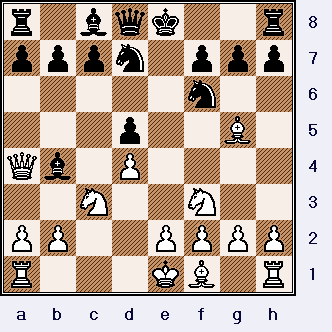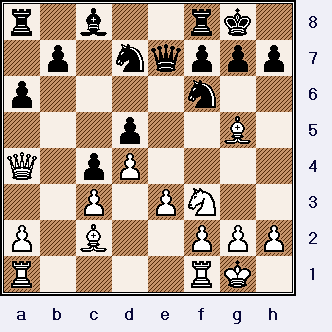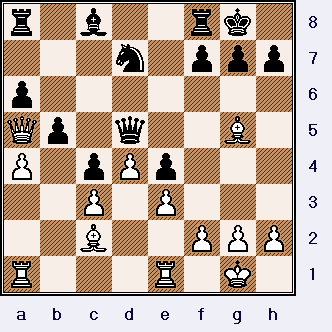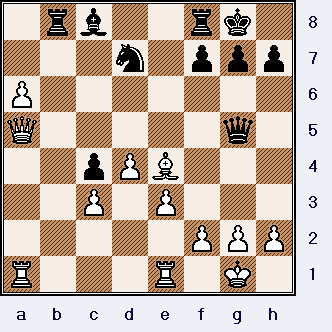All
the |
(Navigation bar
directly below.)
*******
© A.J. Goldsby, 2015.
(All rights reserved.)
****************
Click HERE
to see my
Chess Items.
****************
****************
Buy a book
from Amazon.com
(And help me out as well!)
****************
Click HERE
...
to see a list of the businesses that help to sponsor all of
my chess efforts.
|
|
|---|
|
|
The ratings of each of the players.
In my opinion, you could tack on at least another fifty-to-seventy-five points to all of these players ratings ... in order to get post-2000 equivalent (rating) results. This would have made this a very high-ranking tournament, indeed. |
Click here to see an explanation of the symbols that I use when annotating a chess game. [replay]
GM Jose R. Capablanca
(2748)
- GM Rudolf Spielmann
(2655)
|
|
|
I believe this to be one of Capa's finest and best played games, it also won FIRST brilliancy prize at this tournament!
In this event, six of the world's very best players gathered in one place and played a quadruple round-robin. By today's standards, this event would have been at least a category 19 or even 20 ... and Capa ran away with it. In fact, at the end of the tournament, he began to offer draws from positions where he clearly stood better. If not for this, his winning margin of 2.5 points (with no losses) could have easily been much greater.
**********************************************************************************************
1.d4 d5;
2.Nf3 e6; 3.c4 Nd7; 4.Nc3 Ngf6; 5.Bg5,
By an unusual move order, we have arrived at a standard position for the Queen's Gambit Declined.
[ The move of 5.e3, leads to the ever popular Meran System. ]
5...Bb4!?;
The Manhattan Variation, a sub-variant of the Ragozin System.
(Unusual back then, today this would not even raise an eyebrow.)
6.cxd5 exd5;
7.Qa4!?, (TN?)
This was given an exclam by Reinfeld, but it is not the main line of this system today.
(Of course it is also perfectly playable, and even pretty good for White.)
|
|
r1bqk2r/pppn1ppp/5n2/3p2B1/Qb1P4/2N2N2/PP2PPPP/R3KB1R b
However, Capa is improving on his own play - earlier in this same event - where he only drew that game. [Review that game.]
[ The main line today would be:
7.e3 c5; 8.Bd3 Qa5; 9.Qc2 c4; 10.Bf5 0-0; 11.0-0, "+/=" {D?}
with a small plus for White.A. Karpov - J. Hjartarsson; / ICT, World Cup (Round # 5)
Reykjavik, Iceland; 1991. {White won in 48 moves.}[ See also MCO-14, page # 422; all columns and notes.
(This game - and my note - is closest to column # 77.) ] ]
Here Black surrenders his dark-squared Bishop. While even some authors do not question this idea here, Black might have considered playing something like ...a5 instead.
7...Bxc3+; 8.bxc3 0-0;
9.e3 c5!?; 10.Bd3 c4!?;
The first choice of many programs in the year 2005, the correctness of this play is being debated - even today. I will only comment that even 2000+ players will play this move after long reflection, and that it appears to shut down White's KB. (See
GM John Nunn's long discussion of this move in the Mammoth book of ... "The
World's Greatest Chess Games.")
11.Bc2 Qe7; 12.0-0 a6;
Black appears to have a solid position, most of my students and chess players that I have tested ... believe that Black is equal or even slightly better in this position.
|
|
r1b2rk1/1p1nqppp/p4n2/3p2B1/Q1pP4/2P1PN2/P1B2PPP/R4RK1 w
You may take a look for yourself, and decide which side you believe has the better game here.
Now through a series of forcing moves and exchanges, the great Cuban slowly increases his edge.
13.Rfe1! Qe6;
14.Nd2! b5!?;
15.Qa5! Ne4; 16.Nxe4! dxe4;
17.a4! Qd5!?;
The computer shows that PxP was nearly forced for Black, but White was clearly better in any case.
(Spielmann believes he is gaining time by attacking Capa's unprotected Bishop on g5.)
|
|
r1b2rk1/3n1ppp/p7/Qp1q2B1/P1pPp3/2P1P3/2B2PPP/R3R1K1 w
Take a look at this position. {See the diagram, just above. - ye olde editor}
*** *** *** *** *** *** *** *** *** *** *** *** *** *** *** *** *** *** *** ***
It is White to move in this position, what move would you play here?
18.axb5!!,
(Maybe - '!!!' or '!!!!')
Like a move of the great Tal, none of the gallery understood this move, many onlookers
thought that Capa had simply blundered a piece.
It took real courage to play this move, especially as Capa also had another move, (which he saw); that also gave him a tremendous game.
[ After the simple moves:
(</=) 18.Be7! Re8; 19.axb5! Bb7[]; {This is forced.}( But not </= 19...Rxe7??; as 20.Qd8+,
is clearly winning ("+/-") for White. )20.bxa6, '±' and White stands clearly better. ]
18...Qxg5;
19.Bxe4! Rb8;
This is 100% forced.
[ After the cute variation:
</= 19...Ra7?!; 20.b6! Qxa5; 21.bxa7!!, "+/-"
White is easily winning. ]
20.bxa6!,
(Maybe - '!!')
Most unusual, already down a piece, Capa offers to exchange Queens.
(After long reflection, Spielmann decides that he must avoid this.)
|
|
1rb2rk1/3n1ppp/P7/Q5q1/2pPB3/2P1P3/5PPP/R3R1K1 b
Capablanca was clearly playing inspired chess on this day.
Now White mobilizes his RP ... what is amazing is that Black has so many pieces in that
region of the board, yet is utterly powerless to prevent Capablanca from marching his a-pawn towards the (eventual) promotion square.
20...Rb5;
(Box?)
This is practically forced.
[ It would be a mistake to play: </= 20...Qxa5?; as after 21.Rxa5, ("+/-")
Fritz shows that Black must immediately return the material, (with 21...Bxa6).
{Then the second player would be two pawns down, with a virtually hopeless
position.} ]
Fred Reinfeld referred to White's next
move as a decisive penetration.
21.Qc7! Nb6;
22.a7! Bh3; 23.Reb1!!,
Capa is winning ... but continues to find the very best moves.
(Fritz - after a fairly long period - clearly shows that this is White's best play in this particular position.)
[ Many students have found (instead) the continuation of:
23.Qxb6! Rxb6; 24.a8Q, "+/-" (etc). White is winning
here, but it is not as strong as Capa's line. ]
23...Rxb1+;
24.Rxb1 f5;
Spielmann could have resigned here.
(This would have made this game one of the most brilliant miniatures of all time.)
25.Bf3 f4;
26.exf4!, "+/-" Black Resigns.
The great Cuban is winning easily here, Spielmann was justified in raising the White flag of surrender.
Simply one of Capa's finest games, I dub it "Liberty's Beacon." (A NY reference.)
Copyright (c) A.J. Goldsby, 2006. All rights reserved.
1 - 0
A few good books - where this game is annotated.
I consulted the following books ... in the order given ... in preparing this version of this fantastic game.
# 1.) "The Immortal Games of J.R. Capablanca," by Fred Reinfeld. (Dover re-print.)
# 2.) "The Golden Dozen," (The Twelve Greatest Players Who Ever Lived.); by Irving Chernev.
# 3.)
[The 'Mammoth Book' Of] "The World's Greatest Chess Games," (100 of the best games ever played,
and deep analysis.); by GM J. Nunn,
GM John Emms, & FM G. Burgess. (c) 1998, by Carroll & Graf books.
# 4.)
"Great Brilliancy Prize Games of the Chess Masters," by the late, (great) Fred Reinfeld.
Copyright (c) by the author, 1961. Published by Collier Books of NY.
# 5.)
"Chess Brilliancy," ('250 historic games from the Masters.'); by Iakov Damsky. (c) 2002.
Published by EVERYMAN Chess.
My long version of this game runs over 15 pages with minimal diagrams. -----> Send me an e-mail ... if you would like to obtain a copy of my analysis.
The analysis for this page was prepared with the excellent programs, ChessBase 8.0 and ChessBase 9.0.
The HTML was polished with several different tools and programs, (mostly FP) ... the text was checked for spelling with MS Word.
The diagrams were created with the program, Chess Captor 2.25.
******************************************************************************
This page was first posted on: Friday; June 30th, 2006. Page last edited: Saturday, May 10, 2014 06:18 AM .
[Home] [Site Map] [News page] [Annotated games, # 2] [Best players, Best Games.]
Copyright (©) A.J. Goldsby, 2014. All rights reserved.





